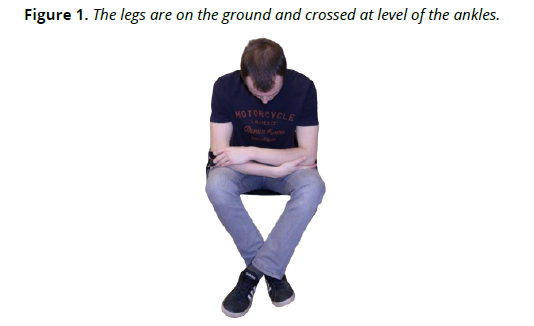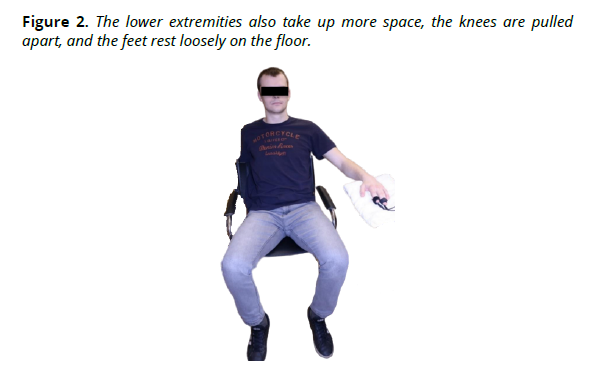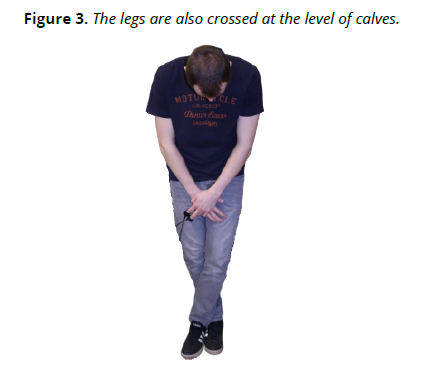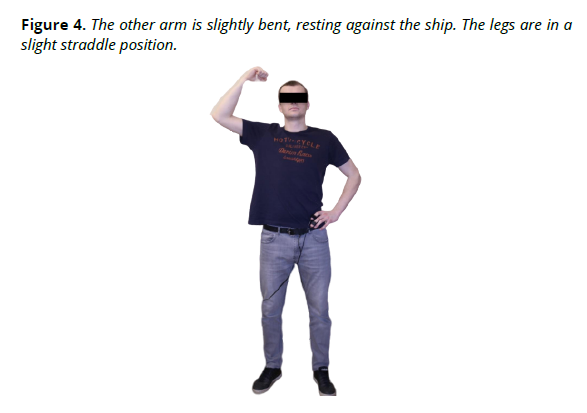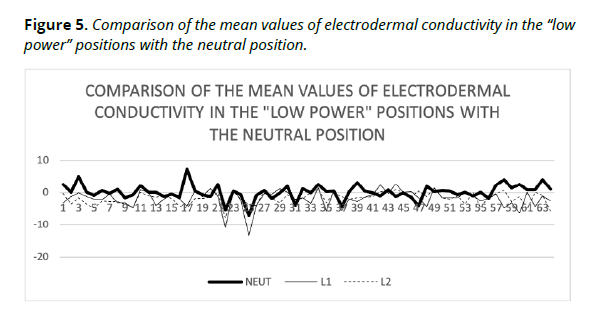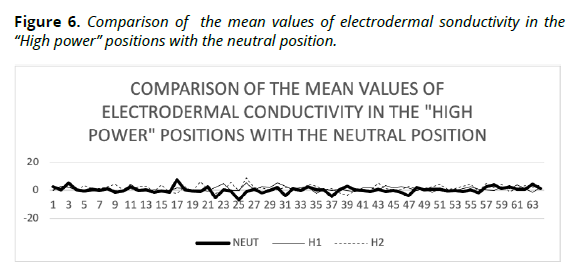Research - (2021) Volume 16, Issue 3
The Impact of Body Position on Changes in Activation of the Nervous System
Daniela Benesova1, Veronika Chocholouskova1, Fabio Jimenez Zazo2 and Karel Svatora1,3**Correspondence: Karel Svatora, Department of Kinanthropology and Humanities, Faculty of Physical Education and Sport, Charles University, Czech Republic, Email:
2PAFS Research Group, Faculty of Sports Sciences, University of Castilla-La Mancha,Pilsen, Spain
3Department of Kinanthropology and Humanities, Faculty of Physical Education and Sport, Charles University, Czech Republic
Received: 24-Apr-2021 Accepted: 17-Jun-2021 Published: 24-Jun-2021
Abstract
Movement behaviour is the mediator of human interactions with the surrounding environment and this behaviour as well as body posture affects how well we do in a great number of psychomotor or sensomotor activities. The aim of our research wasto find out whether, or how, different body positions affect the activation of the autonomic nervous system.
A total of 64 university students (50% females), participated in this cross-sectional study.The activation level of an individual´s nervous system was measured by electrodermal activity in three basic positions: neutral position, “high power” position, and “low power” position, while in the “high power” and “low power” positions, two body positions were always chosen.
The results highlight the statistically and objectively significant differences in skin conductivity (electrodermal activity) between the “high power” and “low power” positions (p < 0.001). By merely adopting the “high power” body positions, electrodermal activity was significantly increased in comparison with the average size of electrodermal activity in the “low power” body positions.
We assume that the individual has a better chance to address successfully mental or movement tasks in the upright body posture (“high power” position).
Keywords
Body position; high power position; low power position; electrodermal activity
El impacto de la posicióndelcuerpo en los cambios de activación del sistemanervioso
Resumen
La forma en la quenosmovemosesconsideradounmediador de lasinteraccioneshumanas con el entorno, y estecomportamiento, asícomo la postura corporal, afecta a nuestrorendimiento en un gran número de actividadespsicomotoras o sensomotoras. El objetivo de nuestrainvestigaciónfueaveriguarcómolasdiferentesposturascorporalesafectan a la activacióndelsistemanerviosoautónomo.
Un total de 64 estudiantesuniversitarios (50% mujeres), participaron en esteestudio transversal. El nivel de activacióndelsistemanervioso del individuo se midiómediante la actividadelectrodérmica en tresposicionesbásicas: posición neutral, posición de "altapotencia" y posición de "bajapotencia".
Los resultadosdestacarondiferenciasestadísticamentesignificativas en la conductividad de la piel (actividadelectrodérmica) entre lasposiciones de "altapotencia" y "bajapotencia" (p < 0,001). Con sóloadoptarlasposicionescorporales de "altapotencia", la actividadelectrodérmicaaumentósignificativamente en comparación con el tamañomedio de la actividadelectrodérmica en lasposicionescorporales de "bajapotencia". Suponemosque el individuotienemásposibilidades de abordar con éxitotareasmentales o de movimiento en la postura corporal erguida (posición de "altapotencia").
Palabras clave: posición corporal; posición de altapotencia; posición de bajapotencia; actividadelectrodérmica
Introduction
Body posture predisposes an individual to how will be perceived by other people, how will be active, therefore, successful (Carney, Cuddy, & Yap, 2010;Cuddy, 2016;Cuddy, Fiske, & Glick, 2008). This is based on the fact that 55% of information is transmitted by people in the form non-verbal communication, and only 45% is transmitted verbally (Mehrabian, 1981). Cuddy (2016) in her long time work mentions mainly the strength of personality, who is not subject to domination and manipulation by other persons and shows that can be objectively measured for example by monitoring of hormone levels.
Carney et al. (2010) investigated the level of two key hormones in saliva, specifically, testosterone and cortisol due to different body positions. They assumed that in power positions testosterone levels will increase and cortisol stress hormone will decrease (de Waal, 1998; Keltner, Gruenfeld, & Anderson, 2003). Keltner et al. (2003) also talk about better management and control over the body and mind, and perception of positive feelings in the power position of the body, and Smith, Jostmann, Galinsky& Van Dijk (2008) talk about the improvement of cognitive functions in this position. Strong persons are active, more often involved in actions (Galinsky, Gruenfeld, & Magee, 2003; Keltner et al., 2003), often exhibit risk-taking behaviour (Anderson & Galinsky, 2006; Davis, Krause, Melhorn, Sakai, & Benoit, 2009) and his body posture is different from the others.
Body posture corresponds to the current mental condition (Lewit, 2003; Stackeová, 2011). The connection between experiencing emotions and posture works in both directions (Barsalou, Niedenthal, Barbey, & Ruppert, 2003; Niedenthal, 2007). Positive emotions provide a sense of power and self-confidence, this is manifested in body posture, the head straight, shoulders are pulled backwards and downwards, getting a regular breathing and strong voice (Burgoon & Dunbar, 2006; Hall, Coats, &LeBeau, 2005). The power of personality gives a person the open-mindedness, optimism, resistance to risk, and increase of the likelihood that the person will notice the opportunity and take it up (Cuddy, 2016; Guinote, 2017).
On the other hand, the loss of power in one sphere of life will change the entire attitude toward the world (Carney et al., 2010). This is followed by the loss of confidence in possibilities, motivation, hope, and ambition of a person, and the person suddenly starts to feel weak and helpless. The sense of helplessness forces us to assess a difficult situation as a threat, and induces a sense of anxiety, which is again demonstrated in the manner of our body posture (Carney et al., 2010). A stressed and exhausted individual tends to cower with the head tilted downwards, and often with the crossed upper or lower extremities, and may begin to feel anxious (Carney et al., 2010).
Both chronic and acute anxiety weaken our most important physiological (Chan et al., 2019) and cognitive functions (Hopko, Robertson, &Lejuez, 2006), thereby interfering with the work of the prefrontal cortex, which ensures that our thinking and actions are in compliance with our inner feelings and personal goals (Paul et al., 2009). If we feel powerless, our ability to think cleverly goes away, and our brain cannot resolve a stressful and complicated situation. All these feelings undermine, what is called by psychologists, executive functions, such as logical reasoning, flexible thinking, control of attention, and other (Cuddy, 2016). All these mental states are closely related to the activation of the nervous system and can be measured (Carney et al., 2010).
Activation of the nervous system underlies the readiness of the organism to react to stimuli (Benešová, 2012). Activation is given by the activity of the sensory organs, and the state of excitement, which are based on existing needs and experienced emotions. Activation is maintained by the inflow of stimuli from the reticular formation of the brain stem into the brain, the so-called non-specific activation (Králíček, 2011). Reticular formation is stimulated by the inflow of stimuli through the collateral pathways from the sensory organs (Moruzzi & Magoun, 1949). The reticular formation activates the cortex and keeps it in the waking state. Both the reticular formation and the limbic system contribute by their discharges to the creation of toning tension of the cerebral cortex (Kulišťák, 2003). Therefore, the level of electrical activity of the brain is a direct indicator of the activation level (Králíček, 2011).
Change in the level of activation, as a response of the organism to external or internal stimuli, is complicated and complex. This change includes not only the integrity of all physiological functions (Chan et al., 2019), but also psychological functions, and variable proportionality of these functions in their presence in the interaction process (Sokolov & Boucsein, 2000). Integration of reactivity within the organism is conditioned by the existence of a wide network of nerve fibers, blood vessels, and capillaries that lead to every part of the body (Mysliveček, 1989). The changes of the level of activation (arousal), can be objectivized by measuring of electrodermal activity (EDA) (Boucsein, 2012).
EDA is measured by monitoring the electrodermal phenomenon of skin named “skin conductivity”. An increase in skin conductivity takes place by increasing its moisture by pre-secretory activity at cell membranes of sweat gland cells (Boucsein et al., 2012). Due to the subjective activity of the autonomous nervous system, especially its sympathetic nervous system, skin conductivity is individually very different (Posada-Quintero et al., 2016). If the skin tissue is connected to a direct current electrical circuit with a low constant voltage, the tissue changes its permeability (i.e. conductivity) to the electric current, depending, among other things, on the psychological activity of the person (Mundy-Castle & McKiever, 1953). In this way, activation of the autonomic nervous system can be objectified by EDA measuring (Boucsein, 2012).
Measuring of EDA was used in many types of research, for example, in the research of positive and negative emotions (Sokolov & Boucsein, 2000), in the research of information processing, and classical and instrumental conditioning (Paul et al., 2009). But, to date, the relationship between different body positions (high and low power positions) and the activation of the autonomic nervous system is not clear.
Therefore, the aim of this study was find out whether, and how, different body positions affect the activation of the autonomic nervous system.
Materials and Methods
Research sample
The sample consisted of 64 participants (50% females). The participants in the study were university students (mean age = 22.6±1.9 years old) of the Faculty of Education of the University of West Bohemia (Czech Republic). The participants were chosen on the basis of their willingness, and no criterion limiting their selection was established. All participants were in good health. Written informed consent to all procedures was obtained prior to testing.
Body position
In our research, we chose five body positions (Carney et al., 2010; Cuddy, Wilmuth, & Carney, 2012). Two positions represented “low power” (L1 and L2), and two positions represented “high power” (H1 and H2). One position was a so-called “neutral” (NEUT) position.
The neutral position was the first measured position, was not intentionally specified by setting the extremities and body to individual positions. We defined only a requirement that the participant would feel relaxed in this position, and his/her body would be in a comfortable setting position. In order to avoid any influence resulting from the subsequent positions, the neutral position was used at the beginning of the test.
The first position, specifically “low power” L1, corresponds in its character to positions expressing helplessness. The participantis sitting on a chair, with the body and head bending forward (see Figure 1). The whole body is tilted downwards. The elbows rest on the thighs, and the hands are closed together in a defensive position.
In the first “high power” H1 position, by changing the position of the extremities, we changed the body into a position expressing strength and power (see Figure 2). The participant is sitting upright on a chair. His/her shoulders are pulled back and the chest expands into space. One arm loosely rests on a mat, which in a close distance from the participant. The goal is to ensure that the chest is spread over to the maximum possible space. The other arm is lowered behind the chair support, in the direction of the floor.
L2 is the second position from the group of inferiority positions expressing helplessness (see Figure 3). The participant is tested in a standing position, the body is curled up, and he/she looks towards the ground. The head is bending forward, the arms are turned down towards the floor, and the hands are crossed.
The “high power” H2 position seems to be powerful at first glance, and perceived as a winning position (see Figure 4). The body is upright, the chin is slightly raised up, and he/she looks upward. One arm is over the head in a victorious gesture with the clenched fist, and flexion in the elbow.
Measurement of electrodermal activity
For the measurement of electrodermal activity, the ML116 GSR Amp device from AD Instrument was used. This device utilises Powe rLab Chart and Power Scope software, which can record and evaluate a time series of skin-galvanic conductivity data between two electrodes placed on the distal phalanges of the index finger and ring finger of the non-dominant hand (Boucsein et al., 2012; Stern, Ray, & Quigley, 2001). Before measurement, the instrument had to be zero calibrated. The device is primarily used for the measurement of the activity level of the autonomic nervous system – activation of the nervous system, thus allowing to analyse the response of the tested subject to stimuli.
Environment for testing and conditions of measurement
Testing was carried out in the laboratory of the Centre of Physical Education and Sports, Faculty of Education of the University of West Bohemia in Pilsen (Czech Republic), where standard research conditions were created. The room had a constant temperature of approximately 22°C. The participants were invited to the room individually in order to avoid affecting the participants with the information obtained from the previous measurement, and to eliminate disturbing stimuli from the external environment. Each of the participants gradually took up the prescribed body position, and stayed in it for 90 seconds (Chocholoušková, 2017). The following variables were measured: Mean of time series of electrodermal conductivity of neutral position (NEUT_MEAN), low power position 1 (L1_MEAN), high power position 1 (H1_MEAN), low power position 2 (L2_MEAN) and high power position 2 (H2_MEAN). The mean values of electrodermal conductivity are given in microsiemens [ηS].
Statistical processing
To evaluate variables of electrodermal conductivity in various body positions, we used the arithmetic mean of the measured time series, obtained after 90 seconds staying in the determined body position.
To evaluate the difference between the L1_MEAN, H1_MEAN, L2_MEAN, and H2_MEAN dependent variables, we used the non-parametric one-way Friedman ANOVA method. The non-parametric method was particularly appropriate, since the normality of frequency distribution of some variables was not proven. For the statistical processing, the STATISTICA 12.0 programme was used.
For practical verification of the obtained results, we used the calculation of substantive significance. If h2> 0.01, we talk about a small effect, if h2 = 0.06, the effect is considered medium, and if h2 = 0.14, the effect is considered large (Morse, 1999).
Results
For clearer interpretation of the results, Table 1 shows the mean values of electrodermal conductivity and standard deviations of the neutral position, as well as the “low power” and “high power” positions.
| MEAN | STD. DV. | |
|---|---|---|
| NEUT_MEAN | -0.58 | 7.28 |
| L1_MEAN | -1.77 | 2.72 |
| H1_MEAN | 1.13 | 1.63 |
| L2_MEAN | -1.70 | 1.86 |
| H2_MEAN | 1.61 | 2.24 |
Note. MEAN = Mean values of electrodermal conductivity; SD = Standard deviation; NEUT_MEAN: Mean value of electrodermal conductivity in neutral position; L1_MEAN: Mean value of electrodermal conductivity in low power position 1; H1_MEAN: Mean value of electrodermal conductivity in high power position 1; L2_MEAN: Mean value of electrodermal conductivity in low power position 2; H2_MEAN Mean value of electrodermal conductivity in high power position 2.
Table 1.
Table 1 clearly shows that the mean values of electrodermal conductivity in the “low power” position were decreased against the neutral position, on average by 1.19 ηS (L1 position), or by 1.12 ηS (L2 position). On the contrary, the mean values of electrodermal conductivity in the “high power” positions were increased by 1.71 ηS (H1 position) and 2.19 ηS (H2 position), in comparison with the neutral position.
Figure 5.
This figure 5 clearly shows that the mean values of electrodermal conductivity were decreased in fifty nineparticipants after taking the “low power” position, and this value was slightly increased only in five participants.
Figure 6
We can see that Figure 6 contains similar information as Figure 5. 90% of the participants showed an increase in the mean values of electrodermal conductivity in the “high power” and neutral positions.
The statistical significance of the differences in the mean values of electrodermal conductivity in the “low power” and “high power” positions was proven by the Friedman χ2 ANOVA calculation. (N = 64, df = 3) = 96.13 p < 0.001. The substantial significance was also assessed as very high (h2 = 0.5).
Discussion
The aim of our research was to find out whether, or how, different body positions affect the activation of the autonomic nervous system. We have proved that body posture can significantly affect the activation level of the individual's nervous system.
The activation of the nervous system affects not only our alertness and attention, but also emotional processes. This variable affects our current mental condition and body posture and vice versa (Veenstra, Schneider, &Koole, 2017). Changes in the psychophysiological condition are critical for the control of ongoing emotions (Critchley, Mathias, & Dolan, 2001). A change in the body position may significantly change the mood of each individual (Peper, Harvey, & Hamiel, 2019).
The proper body posture, i.e. chest and head in the “high power” positions, is a prerequisite for the correct position of the spine that affects the work of respiratory muscles (Dejanovic, Balkovec, & McGill, 2015; Han, Park, Kim, Choi, &Lyu, 2016; Jung, Lee, Kang, Kim, & Lee, 2016; Szczygieł et al., 2018). The “low power” positions, characterised by hanging the head and extending the thoracic kyphosis, are regarded as incorrect body postures. We can assume from the above-mentioned facts that the correct, physiological body posture can predispose individual persons to activation, higher attention, selfconfidence, and leads us to return to the ancient, simple, but valid saying of the ancient Greeks: “menssana in corporesano” - “a healthy mind in a healthy body”.
When taking a neutral position, a high variance of the means of time series of electrodermal conductivity was found in the research sample. This is attributable to the fact that each of the participants took a slightly different position, as the only task was to take a very comfortable position. The variance in individual positions was relatively small. This observation also confirms our presumption that the participants reacted very similarly to the changed body position. If the participants took the helplessness “low power” position, activation of the nervous system was decreased, and, on the contrary, if the bodies took the “high power” position, this activation was increased.
The study have the following strengths. Objective method was used to quantify the activity in the skin based on electrodermal activity. This method can identify increasing or decreasing skin surface conductivity occurs by increasing or decreasing the skin moisture, caused by the activity of sweat gland cells (which represents activity of autonomic nervous system) (Boucsein, 2012). On the other hand, our study has several limitations. In the measurement of electrodermal activity, a number of factors play a role. We can control and influence some of them (such as temperature and humidity in a laboratory environment, lighting, or electrode pressure applied on fingers), but the measurement can also be influenced by some factors that are beyond our control (such as degree of hydration of the subject, individual sweating during testing, current psychological condition of the subject, and the like). It must further be noted the fact that the research sample did not consist of a representative sample. The sample was a convenience sample. The research sample consisted of university students from the Faculty of Education of the University of West Bohemia in Pilsen, therefore, we can state that it was homogeneous from the point of view of age.
In conclusion our research determined that high-power positions were related to higher activation of nervous-system (arousal). We believe that our findings should be further investigated and, above all, practically applied to various human activities, such as learning, work activities, or sports.
Acknowledgements
This work was supported by West Bohemia University under grant No. SGS- 2021-002 and by Charles University in Prague under grant GA UK No. 186120.
References
Anderson, C., &Galinsky, A. D. (2006).Power, optimism, and risk-taking.European Journal of Social Psychology, 36(4), 511–536. https://doi.org/10.1002/ejsp.324
Barsalou, W. , L., Niedenthal, M. , P., Barbey, K. , A., &Ruppert, A. , J. (2003). Social embodiment. In H. , B. Ross (Ed.), The Psychology of Learning and Motivation (Vol. 43, pp. 43–92). San Diego: Elsevier Science.
Benešová, D. (2012). Aktivačníúroveň v průběhutestubimanuálníkoordinace.StudiaKinanthropologica, 13(1), 12–19.
Boucsein, W. (2012).Electrodermal Activity. Boston: Springer. https://doi.org/10.1007/978-1-4614-1126-0
Boucsein, W., Fowles, D. C., Grimnes, S., Ben-Shakhar, G., Roth, W. T., Dawson, M. E., &Filion, D. L. (2012).Publication recommendations for electrodermal measurements.Psychophysiology, 49(8).https://doi.org/10.1111/j.1469-8986.2012.01384.x
Burgoon, J. K., & Dunbar, N. E. (2006).Nonverbal Expressions of Dominance and Power in Human Relationships. In V. Manusov& M. , L. Patterson (Eds.), The SAGE Handbook of Nonverbal Communication. California: SAGE Publications, Inc. https://doi.org/10.4135/9781412976152.n15
Carney, D. R., Cuddy, A. J. C., & Yap, A. J. (2010). Power Posing: Brief Nonverbal Displays Affect Neuroendocrine Levels and Risk Tolerance. Psychological Science, 21(10).https://doi.org/10.1177/0956797610383437
Chan, P.-Y. S., Wu, Y.-T., Hsu, A.-L., Li, C.-W., Wu, C. W., von Leupoldt, A., & Hsu, S.-C. (2019). The effect of anxiety on brain activation patterns in response to inspiratory occlusions: an fMRI study. Scientific Reports, 9(1).https://doi.org/10.1038/s41598-019-51396-2
Chocholoušková, V. (2017).Electrodermal activity in case of posture changing.Pilsen.
Critchley, H. D., Mathias, C. J., & Dolan, R. J. (2001).Neuroanatomical basis for first-and second-order representations of bodily states.Nature Neuroscience, 4(2).https://doi.org/10.1038/84048
Cuddy, A. (2016).Presence: Bringing Your Boldest Self to Your Biggest Challenges. London: Orion Publishing Co.
Cuddy, A. J. C., Fiske, S. T., & Glick, P. (2008). Warmth and Competence as Universal Dimensions of Social Perception: The Stereotype Content Model and the BIAS Map. Advances in Experimental Social Psychology, Vol. 40.https://doi.org/10.1016/S0065-2601(07)00002-0
Cuddy, A. J. C., Wilmuth, C. A., & Carney, D. R. (2012).The Benefit of Power Posing Before a High-Stakes Social Evaluation.In Harvard Business School Working Paper (Vol. 13).
Davis, J. F., Krause, E. G., Melhorn, S. J., Sakai, R. R., & Benoit, S. C. (2009). Dominant rats are natural risk takers and display increased motivation for food reward. Neuroscience, 162(1).https://doi.org/10.1016/j.neuroscience.2009.04.039
de Waal, F. (1998). Chimpanzee politics: Power and sex among apes. Baltimore: Johns hopkins.
Dejanovic, A., Balkovec, C., & McGill, S. (2015). Head posture influences low back muscle endurance tests in 11-year-old children. Journal of Motor Behavior, 47(3).https://doi.org/10.1080/00222895.2014.974493
Galinsky, A. D., Gruenfeld, D. H., & Magee, J. C. (2003).From Power to Action.Journal of Personality and Social Psychology, 85(3).https://doi.org/10.1037/0022-3514.85.3.453
Guinote, A. (2017). How Power Affects People: Activating, Wanting, and Goal Seeking. Annual Review of Psychology, 68(1).https://doi.org/10.1146/annurev-psych-010416-044153
Hall, J. A., Coats, E. J., &LeBeau, L. S. (2005). Nonverbal Behavior and the Vertical Dimension of Social Relations: A Meta-Analysis. Psychological Bulletin, 131(6).https://doi.org/10.1037/0033-2909.131.6.898
Han, J., Park, S., Kim, Y., Choi, Y., &Lyu, H. (2016). Effects of forward head posture on forced vital capacity and respiratory muscles activity. Journal of Physical Therapy Science, 28(1).https://doi.org/10.1589/jpts.28.128
Hopko, D. R., Robertson, S. M. C., &Lejuez, C. W. (2006). Behavioral activation for anxiety disorders.The Behavior Analyst Today, 7(2).https://doi.org/10.1037/h0100084
Jung, S. I., Lee, N. K., Kang, K. W., Kim, K., & Lee, D. Y. (2016). The effect of smartphone usage time on posture and respiratory function.Journal of Physical Therapy Science, 28(1).https://doi.org/10.1589/jpts.28.186
Keltner, D., Gruenfeld, D. H., & Anderson, C. (2003).Power, Approach, and Inhibition.Psychological Review, Vol. 110. https://doi.org/10.1037/0033-295X.110.2.265
Králíček, P. (2011). Úvod do speciálníneurofyziologie. Praha: Galén.
Kulišťák, P. (2003). Neuropsychologie.Praha: Portál.
Lewit, K. (2003). Manipulačníléčba v myoskeletálnímedicíně (5.).Praha: Sdělovacítechnika.
Mehrabian, A. (1981). Silent messages: Implicit communication of emotions and attitudes. Belmont: Wadsworth.
Morse, D. T. (1999). MINSIZE2: A computer program for determining effect size and minimum sample size for statistical significance for univariate, multivariate, and nonparametric tests. Educational and Psychological Measurement, 59(3).https://doi.org/10.1177/00131649921969901
Moruzzi, G., &Magoun, H. W. (1949).Brain stem reticular formation and activation of the EEG.Electroencephalogr Clin Neurophysiol ., 1(4), 455–473.
Mundy-Castle, A. C., &McKiever, B. L. (1953).The psychophysiological significance of the galvanic skin response.Journal of Experimental Psychology, 46(1).https://doi.org/10.1037/h0060100
Mysliveček, J. (1989). Nervovásoustava: Funkce, struktura a poruchyčinnosti. Praha: Avicenum.
Niedenthal, P. M. (2007). Embodying Emotion.Science, 316(5827).https://doi.org/10.1126/science.1136930
Paul, R., Grieve, S. M., Chaudary, B., Gordon, N., Lawrence, J., Cooper, N., … Gordon, E. (2009). Relative contributions of the cerebellar vermis and prefrontal lobe volumes on cognitive function across the adult lifespan.Neurobiology of Aging, 30(3).https://doi.org/10.1016/j.neurobiolaging.2007.07.017
Peper, E., Harvey, R., &Hamiel, D. (2019).Transforming Thoughts with Postural Awareness to Increase Therapeutic and Teaching Efficacy.NeuroRegulation, 6(3).https://doi.org/10.15540/nr.6.3.153
Posada-Quintero, H. F., Florian, J. P., Orjuela-Cañón, A. D., Aljama-Corrales, T., Charleston-Villalobos, S., & Chon, K. H. (2016). Power Spectral Density Analysis of Electrodermal Activity for Sympathetic Function Assessment. Annals of Biomedical Engineering, 44(10).https://doi.org/10.1007/s10439-016-1606-6
Smith, P. K., Jostmann, N. B., Galinsky, A. D., & van Dijk, W. W. (2008). Lacking power impairs executive functions: Research article. Psychological Science, 19(5).https://doi.org/10.1111/j.1467-9280.2008.02107.x
Sokolov, E. N., &Boucsein, W. (2000).A psychophysiological model of emotion space.Integrative Physiological and Behavioral Science, 35(2).https://doi.org/10.1007/BF02688770
Stackeová, D. (2011). Relaxačnítechnikyvesportu.Praha: Grada Publishing.
Stern, M. R., Ray, W. J., & Quigley, K. S. (2001). Psychophysiological recording (2nd ed.). New York: Oxford University Press.
Szczygieł, E., Blaut, J., Zielonka-Pycka, K., Tomaszewski, K., Golec, J., Czechowska, D., …Golec, E. (2018). The Impact of Deep Muscle Training on the Quality of Posture and Breathing.Journal of Motor Behavior, 50(2).https://doi.org/10.1080/00222895.2017.1327413
Veenstra, L., Schneider, I. K., &Koole, S. L. (2017).Embodied mood regulation: the impact of body posture on mood recovery, negative thoughts, and mood-congruent recall.Cognition and Emotion, 31(7).https://doi.org/10.1080/02699931.2016.1225003
